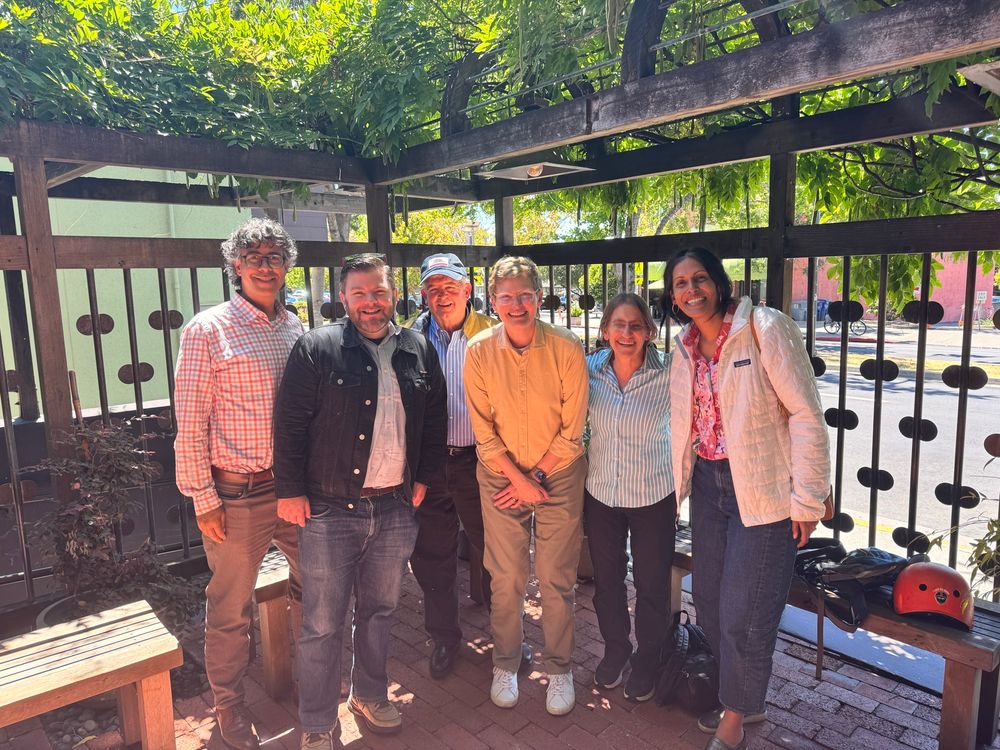
Wonderful Chez Panisse lunch with equally wonderful people - City Manager Paul Buddenhagen, @ericpanzer.bsky.social, @loridroste.bsky.social, Beth Gerstein, and Councilmember Rashi Kesarwani. Lori is leaving our staff to become planning and housing director for SPUR!
03.08.2025 19:45 — 👍 9 🔁 1 💬 0 📌 0
What a week for Berkeley:
-passed the budget addressing the structural deficit
-opened the Willard Clubhouse which will children and families across Berkeley
-passed Missing Middle 🎉 to address skyrocketing housing costs and scarcity
I couldn’t be prouder of our city.
27.06.2025 14:21 — 👍 5 🔁 0 💬 1 📌 0
“when can my city get a Zohran”
we already have our in Berkeley, that’s @cecilialunaparra.bsky.social, she makes housing vision charts with rose logos on them
27.06.2025 06:26 — 👍 97 🔁 17 💬 3 📌 0
It's done!! On a unanimous council vote, and after 6+ years, countless hours of public comment, and more than 40 community meetings...
...Berkeley has *officially* ended single-family only zoning and legalized multifamily housing citywide!!!
27.06.2025 06:53 — 👍 320 🔁 47 💬 4 📌 12
Hooray!
27.06.2025 14:07 — 👍 5 🔁 0 💬 0 📌 0
CM Kesarwani is making a motion! It would allow up to 70 units/acre, an effectiveness analysis report being triggered after 2 years or 25 projects, and a few other add-ons.
And folks, it's unanimous!
After more than 6 years, Berkeley has *finally* eliminated single-family only zoning!!!
27.06.2025 06:50 — 👍 142 🔁 18 💬 3 📌 10
CM Kesarwani speaking now, looking like we're going to compromise at 70 du/a, which is still extremely reasonable!
27.06.2025 06:37 — 👍 16 🔁 1 💬 1 📌 0
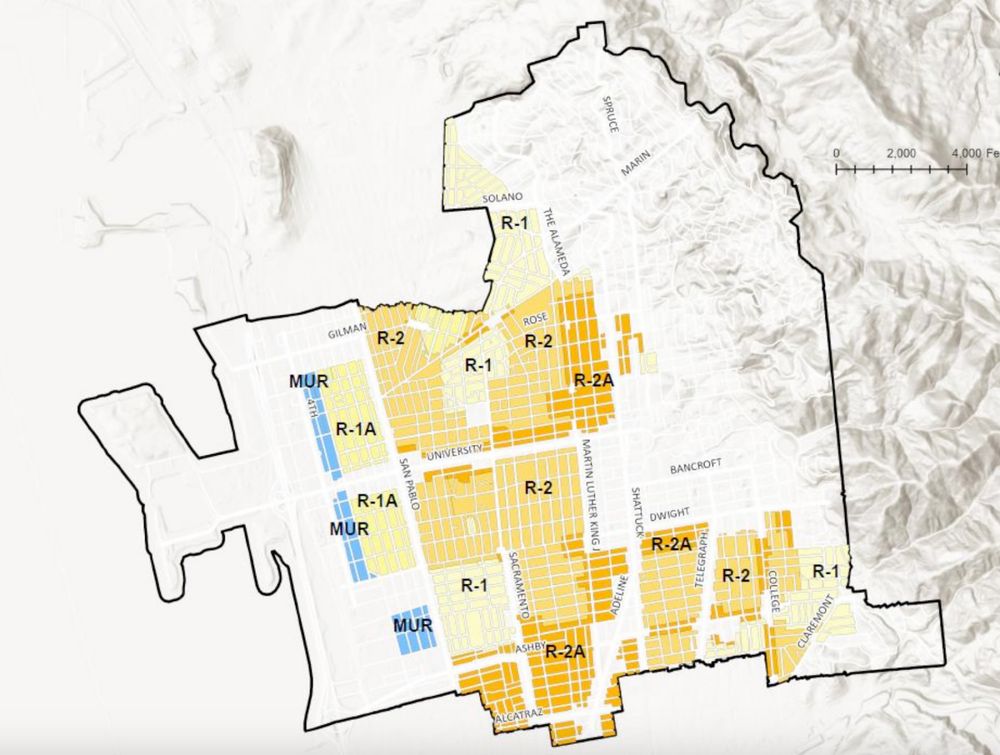
Sounds like Berkeley City Council has that votes to replace all residential zoning (outside the firezones) with Middle Housing after 6 years of debate and studies. 70 dwelling units per acre, 60% lot coverage, 3-story limit. In all non-fire risk residential zones below.
27.06.2025 06:41 — 👍 168 🔁 12 💬 4 📌 8
We're on to council comments now. Incredible comment from CM Humbert on the need for this rezoning: are we truly an equitable community, or are we just cosplaying as one?
🔥🔥🔥
27.06.2025 05:53 — 👍 61 🔁 2 💬 3 📌 1
Comment of the night goes to Mily, a young renter who says she was priced out of the city.
She uses the rest of her time to cite things that took less time than this rezoning, including:
- The Civil War
- WWI
- US involvement in WW2
- Construction of the Bay Bridge
- The dot com bubble
27.06.2025 05:49 — 👍 202 🔁 35 💬 3 📌 8
You guys have no idea how crazy it is to see local berkeley pro housing folks of all ages dominate the council hearing for Middle Housing. I thought we were going to get swamped for sure with all the fearmongering.
27.06.2025 05:33 — 👍 142 🔁 7 💬 3 📌 0
Happy Thursday, folks!
I'm spending my evening (virtually) in Berkeley, where the City Council will *finally* vote on the Middle Housing Ordinance to legalize duplexes, fourplexes & small apartments in most neighborhoods throughout the city.
Grab some 🍿, 🧵 starts here!
27.06.2025 02:11 — 👍 176 🔁 17 💬 4 📌 15
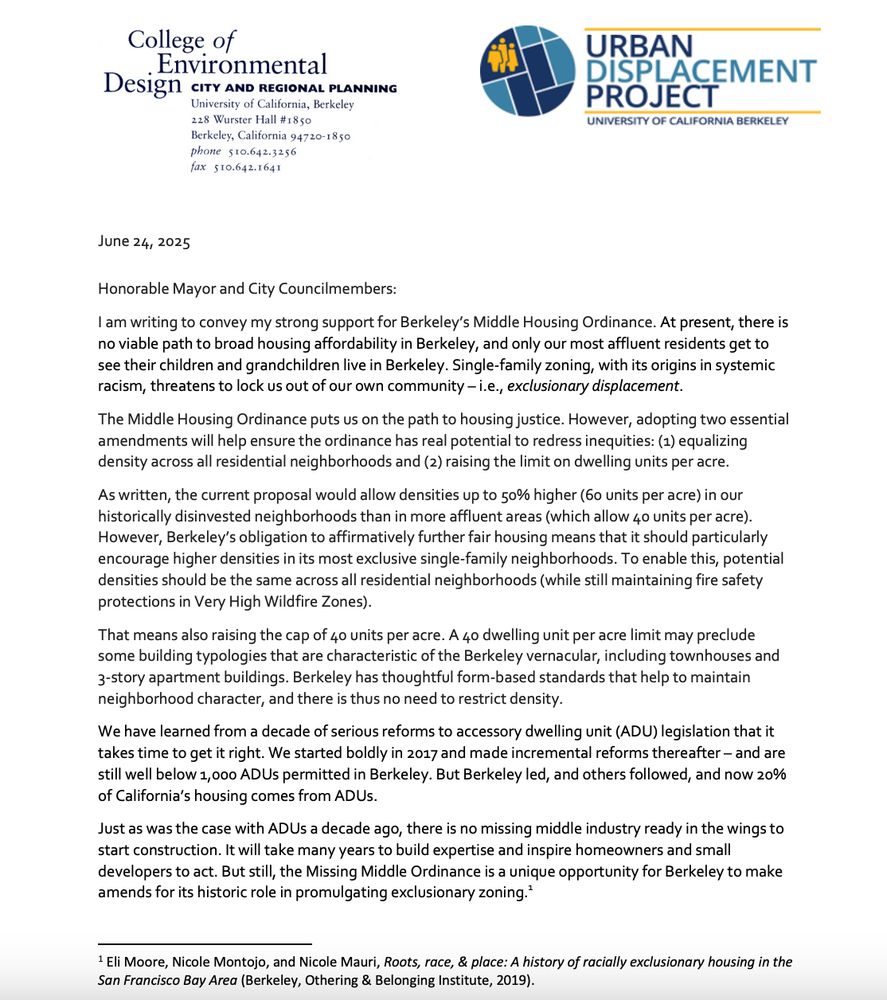
Honorable Mayor and City Councilmembers:
I am writing to convey my strong support for Berkeley's Middle Housing Ordinance. At present, there is no viable path to broad housing affordability in Berkeley, and only our most affluent residents get to see their children and grandchildren live in Berkeley. Single-family zoning, with its origins in systemic racism, threatens to lock us out of our own community - i.e., exclusionary displacement.
The Middle Housing Ordinance puts us on the path to housing justice. However, adopting two essential amendments will help ensure the ordinance has real potential to redress inequities: (1) equalizing density across all residential neighborhoods and (2) raising the limit on dwelling units per acre.
As written, the current proposal would allow densities up to 50% higher (6o units per acre) in our historically disinvested neighborhoods than in more affluent areas (which allow 40 units per acre).
However, Berkeley's obligation to affirmatively further fair housing means that it should particularly encourage higher densities in its most exclusive single-family neighborhoods. To enable this, potential densities should be the same across all residential neighborhoods (while still maintaining fire safety protections in Very High Wildfire Zones).
That means also raising the cap of 40 units per acre. A 40 dwelling unit per acre limit may preclude some building typologies that are characteristic of the Berkeley vernacular, including townhouses and
3-story apartment buildings. Berkeley has thoughtful form-based standards that help to maintain neighborhood character, and there is thus no need to restrict density.
We have learned from a decade of serious reforms to accessory dwelling unit (ADU) legislation that it takes time to get it right. We started boldly in 2017 and made incremental reforms thereafter - and are still well below 1,000 ADUs permitted in Berkeley. But Berkeley led, and others followed, and now 20% of California's housing comes …
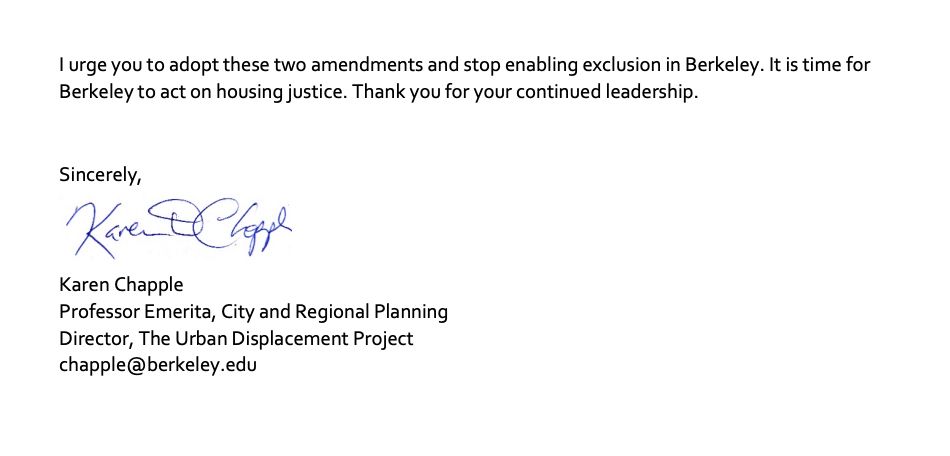
I urge you to adopt these two amendments and stop enabling exclusion in Berkeley. It is time for Berkeley to act on housing justice. Thank you for your continued leadership.
Sincerely,
Karen Chapple
Professor Emerita, City and Regional Planning
Director, The Urban Displacement Project
Karen Chapple, preeminent scholar on anti-displacement policy supports Berkeley’s missing middle ordinance
25.06.2025 17:23 — 👍 20 🔁 5 💬 0 📌 1

Honorable Mayor and City Councilmembers:
I am writing to convey my strong support for Berkeley's Middle Housing Ordinance. At present, there is no viable path to broad housing affordability in Berkeley, and only our most affluent residents get to see their children and grandchildren live in Berkeley. Single-family zoning, with its origins in systemic racism, threatens to lock us out of our own community - i.e., exclusionary displacement.
The Middle Housing Ordinance puts us on the path to housing justice. However, adopting two essential amendments will help ensure the ordinance has real potential to redress inequities: (1) equalizing density across all residential neighborhoods and (2) raising the limit on dwelling units per acre.
As written, the current proposal would allow densities up to 50% higher (6o units per acre) in our historically disinvested neighborhoods than in more affluent areas (which allow 40 units per acre).
However, Berkeley's obligation to affirmatively further fair housing means that it should particularly encourage higher densities in its most exclusive single-family neighborhoods. To enable this, potential densities should be the same across all residential neighborhoods (while still maintaining fire safety protections in Very High Wildfire Zones).
That means also raising the cap of 40 units per acre. A 40 dwelling unit per acre limit may preclude some building typologies that are characteristic of the Berkeley vernacular, including townhouses and
3-story apartment buildings. Berkeley has thoughtful form-based standards that help to maintain neighborhood character, and there is thus no need to restrict density.
We have learned from a decade of serious reforms to accessory dwelling unit (ADU) legislation that it takes time to get it right. We started boldly in 2017 and made incremental reforms thereafter - and are still well below 1,000 ADUs permitted in Berkeley. But Berkeley led, and others followed, and now 20% of California's housing comes …

I urge you to adopt these two amendments and stop enabling exclusion in Berkeley. It is time for Berkeley to act on housing justice. Thank you for your continued leadership.
Sincerely,
Karen Chapple
Professor Emerita, City and Regional Planning
Director, The Urban Displacement Project
Karen Chapple, preeminent scholar on anti-displacement policy supports Berkeley’s missing middle ordinance
25.06.2025 17:23 — 👍 20 🔁 5 💬 0 📌 1
More critical support for Thursday’s middle housing proposal in Berkeley!
24.06.2025 17:07 — 👍 6 🔁 2 💬 0 📌 0
We love to see leading environmentalists thinking globally and acting locally.
24.06.2025 17:29 — 👍 95 🔁 12 💬 2 📌 0
Housing policy is climate policy
24.06.2025 17:42 — 👍 26 🔁 3 💬 1 📌 0

Dear Mayor and City Councilmembers,
As a scholar of racial inequality, segregation, and land use,
(1 who also works in Berkeley, I strongly support the adoption of Berkeley's Missing
Middle Ordinance, a necessary plan to expand housing at a critical range, and urge you to strengthen it by adopting two important amendments. These changes help ensure the ordinance meets its full potential as a tool for equitable, inclusive growth. Without them, the policy risks falling short of its goals and inadvertently reinforcing the very inequities it seeks to address.
1. Equalize Density Across All Residential Neighborhoods
The current proposal allows just 40 units per acre in most areas previously zoned for single-family homes, while permitting up to 60 units per acre in neighborhoods that have experienced redlining and underinvestment. While this disparity may reflect historical zoning, it also risks perpetuating exclusion by continuing to constrain housing growth in wealthier, high-opportunity neighborhoods where children and families can thrive.
This inequity could also place the City at odds with California's legal obligation under Government Code § 65583(c)(10) to affirmatively further fair housing. Restricting density in affluent areas shifts new development onto communities that have already faced decades of disinvestment and displacement.
Equalizing density across all residential neighborhoods-while maintaining fire safety protections in Very High Wildfire Zones-would:
• Ensure that all communities participate in addressing Berkeley's housing needs
• Advance racial and economic justice in a measurable, structural way
• Distribute housing growth more equitably and reduce displacement risk citywide
2. Consider Raising the Dwelling Units Per Acre Limit
Berkeley's emphasis on form-based standards-such as setbacks, height limits, and open space-has advantages in the direction of more predictable and thoughtful housing design. However, capping density at 40 dwelling units per…
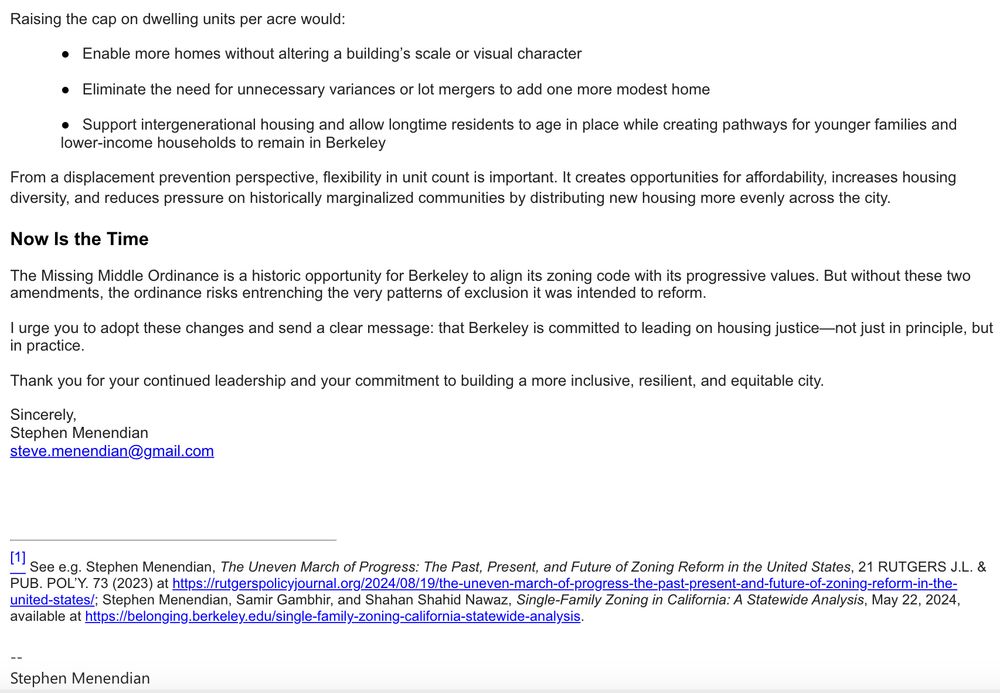
Dear Mayor and City Councilmembers,
As a scholar of racial inequality, segregation, and land use,
(1 who also works in Berkeley, I strongly support the adoption of Berkeley's Missing
Middle Ordinance, a necessary plan to expand housing at a critical range, and urge you to strengthen it by adopting two important amendments. These changes help ensure the ordinance meets its full potential as a tool for equitable, inclusive growth. Without them, the policy risks falling short of its goals and inadvertently reinforcing the very inequities it seeks to address.
1. Equalize Density Across All Residential Neighborhoods
The current proposal allows just 40 units per acre in most areas previously zoned for single-family homes, while permitting up to 60 units per acre in neighborhoods that have experienced redlining and underinvestment. While this disparity may reflect historical zoning, it also risks perpetuating exclusion by continuing to constrain housing growth in wealthier, high-opportunity neighborhoods where children and families can thrive.
This inequity could also place the City at odds with California's legal obligation under Government Code § 65583(c)(10) to affirmatively further fair housing. Restricting density in affluent areas shifts new development onto communities that have already faced decades of disinvestment and displacement.
Equalizing density across all residential neighborhoods-while maintaining fire safety protections in Very High Wildfire Zones-would:
• Ensure that all communities participate in addressing Berkeley's housing needs
• Advance racial and economic justice in a measurable, structural way
• Distribute housing growth more equitably and reduce displacement risk citywide
2. Consider Raising the Dwelling Units Per Acre Limit
Berkeley's emphasis on form-based standards-such as setbacks, height limits, and open space-has advantages in the direction of more predictable and thoughtful housing design. However, capping density at 40 dwelling units per…
Stephen Menendian, preeminent scholar of racial inequality, segregation, and land use strongly urges Berkeley to pass the middle housing ordinance.
24.06.2025 23:35 — 👍 23 🔁 5 💬 0 📌 0
I’m so sorry. I’m new at this app. I will try to figure it out.
24.06.2025 23:33 — 👍 0 🔁 0 💬 1 📌 0
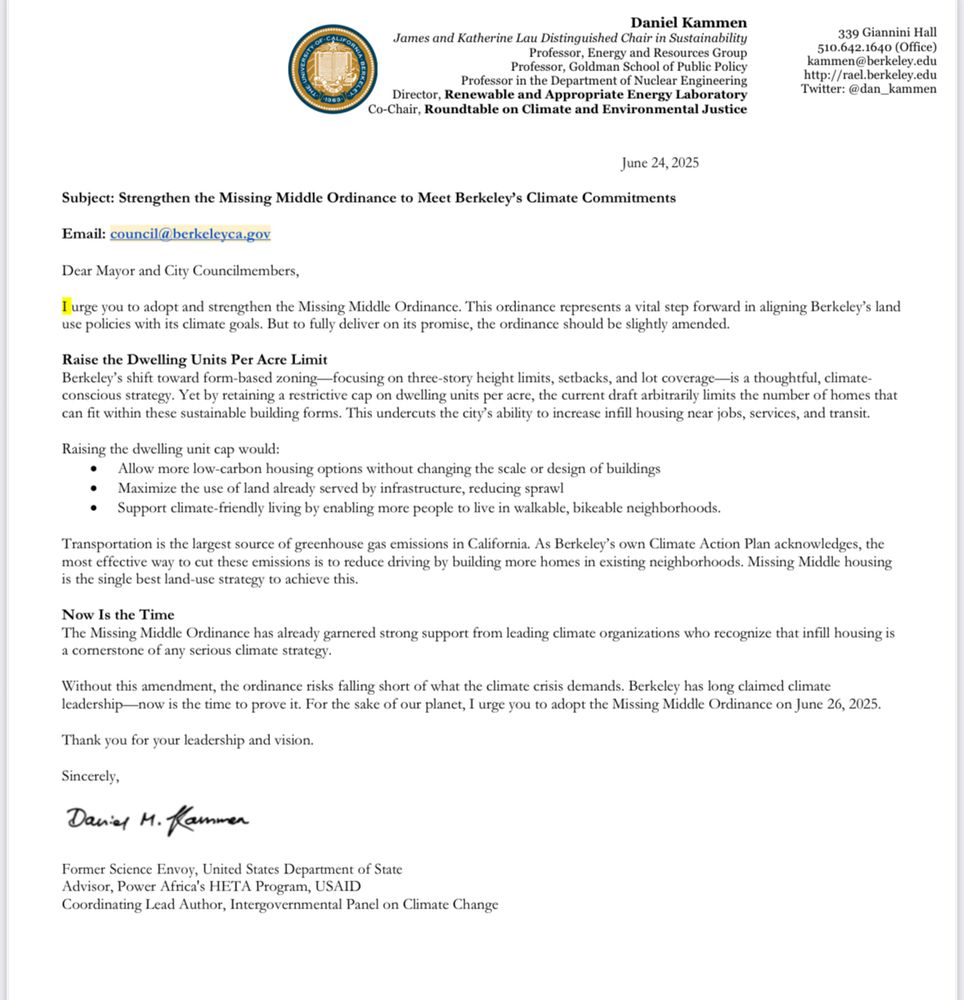
Nobel Prize winning climate scientist, coordinating lead author of Intergovernmental Panel on Climate Change and Former US State Department Science Envoy SUPPORTS MIDDLE HOUSING ordinance in Berkeley
24.06.2025 17:05 — 👍 155 🔁 30 💬 3 📌 5
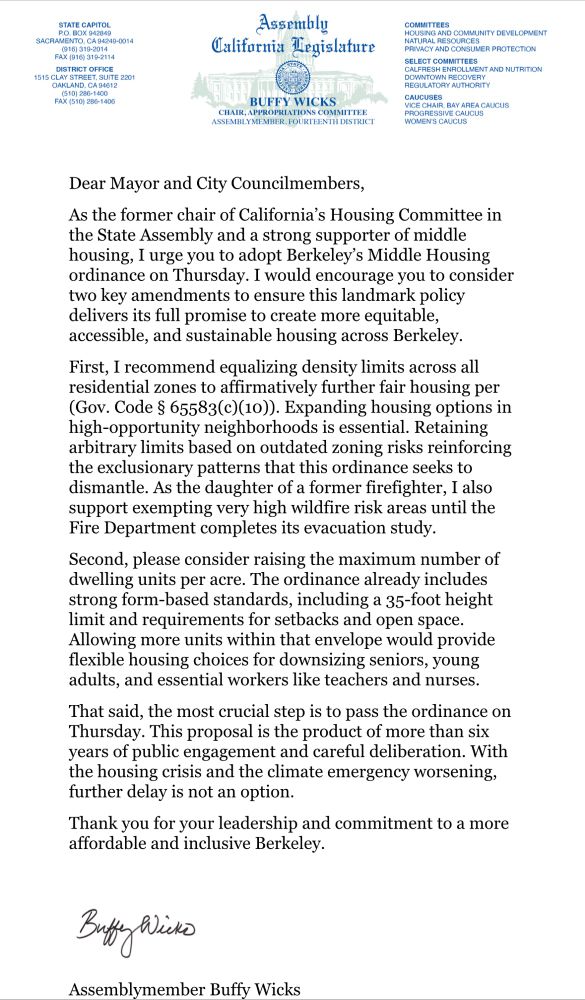
Assemblymember Buffy Wicks urges Berkeley to support middle housing ordinance
24.06.2025 01:58 — 👍 7 🔁 2 💬 0 📌 0
Housing Policy is Climate Policy
23.06.2025 15:42 — 👍 6 🔁 2 💬 0 📌 0
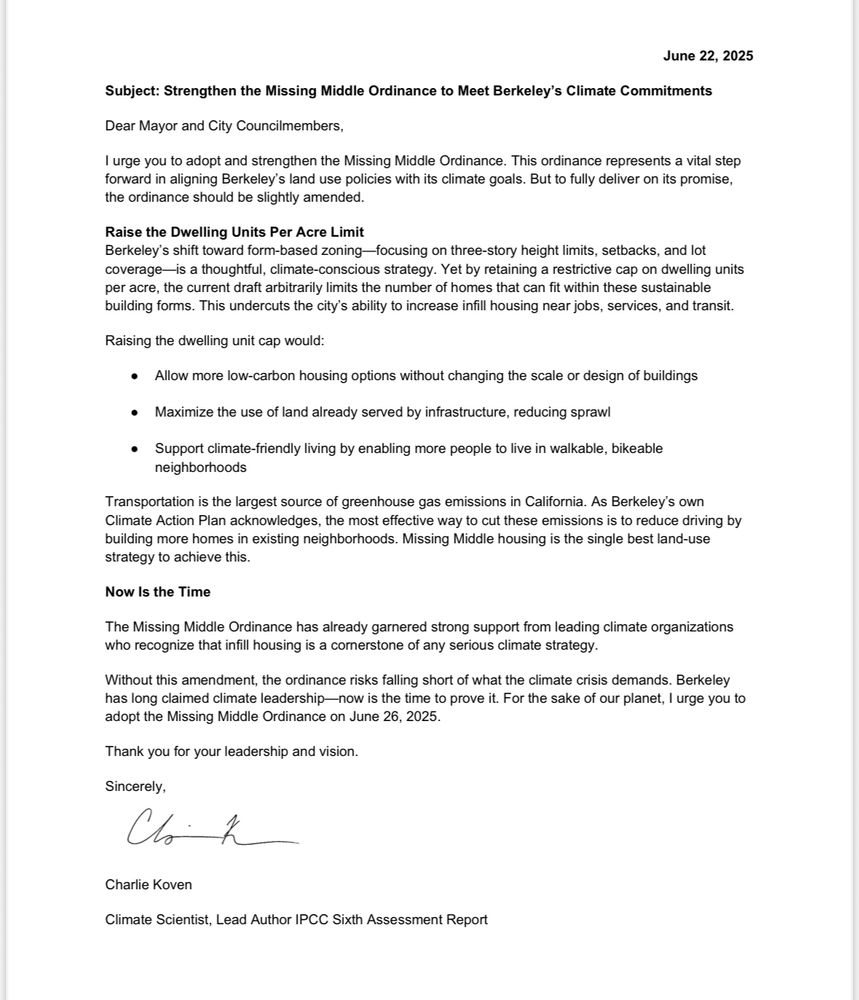
Intergovernmental Panel on Climate Change scientists urge support of Berkeley’s middle housing ordinance.
23.06.2025 14:59 — 👍 59 🔁 19 💬 1 📌 1
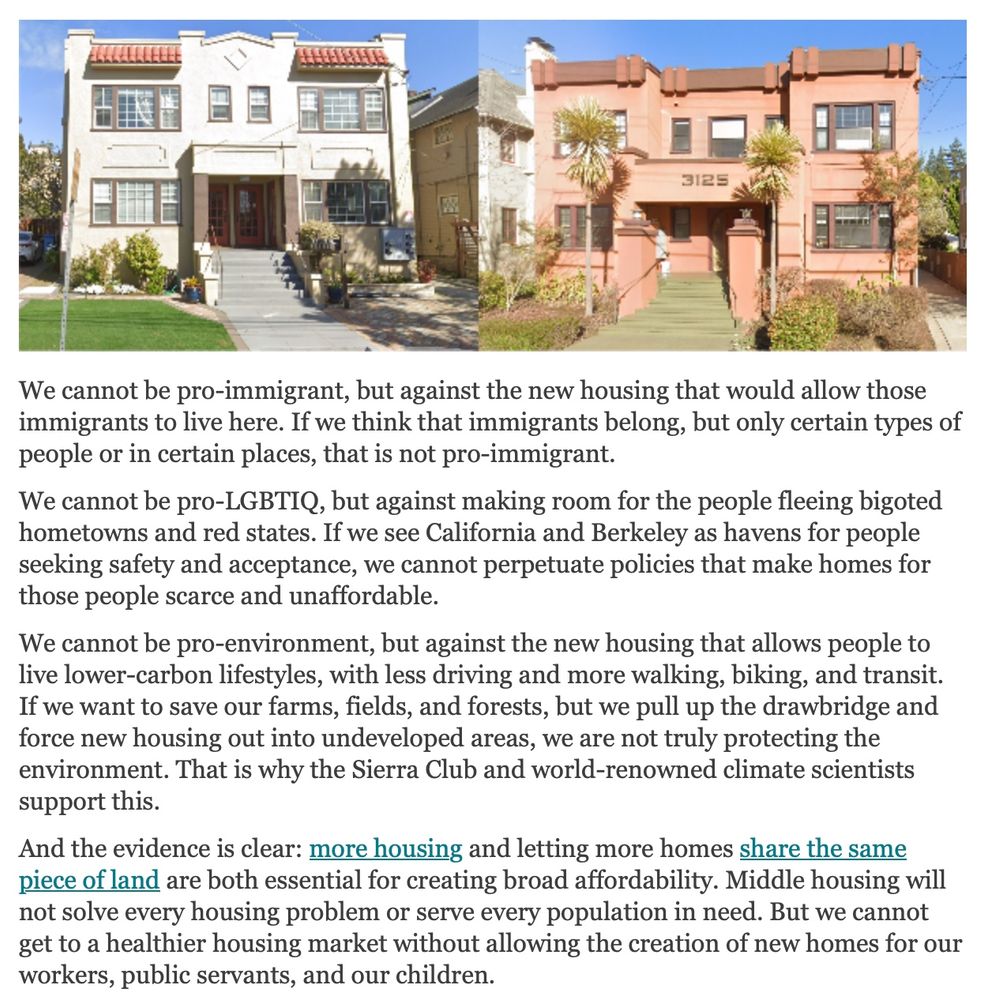
A clip from Mark Humbert's newsletter, showing two small apartment buildings with maybe 4-6 units each. Below them, Mark writes the following:
We cannot be pro-immigrant, but against the new housing that would allow those immigrants to live here. If we think that immigrants belong, but only certain types of people or in certain places, that is not pro-immigrant.
We cannot be pro-LGBTIQ, but against making room for the people fleeing bigoted hometowns and red states. If we see California and Berkeley as havens for people seeking safety and acceptance, we cannot perpetuate policies that make homes for those people scarce and unaffordable.
We cannot be pro-environment, but against the new housing that allows people to live lower-carbon lifestyles, with less driving and more walking, biking, and transit. If we want to save our farms, fields, and forests, but we pull up the drawbridge and force new housing out into undeveloped areas, we are not truly protecting the environment. That is why the Sierra Club and world-renowned climate scientists support this.
And the evidence is clear: more housing and letting more homes share the same piece of land are both essential for creating broad affordability. Middle housing will not solve every housing problem or serve every population in need. But we cannot get to a healthier housing market without allowing the creation of new homes for our workers, public servants, and our children.
I very much appreciate this argument for "missing middle" housing in #Berkeley, from my City Councilmember, @markhumbert.bsky.social. Berkeley (and elsewhere) regularly leaves a big gap between our stated values and our actions. Mark is calling on us to close that gap, and I agree.
20.06.2025 14:45 — 👍 33 🔁 11 💬 0 📌 2
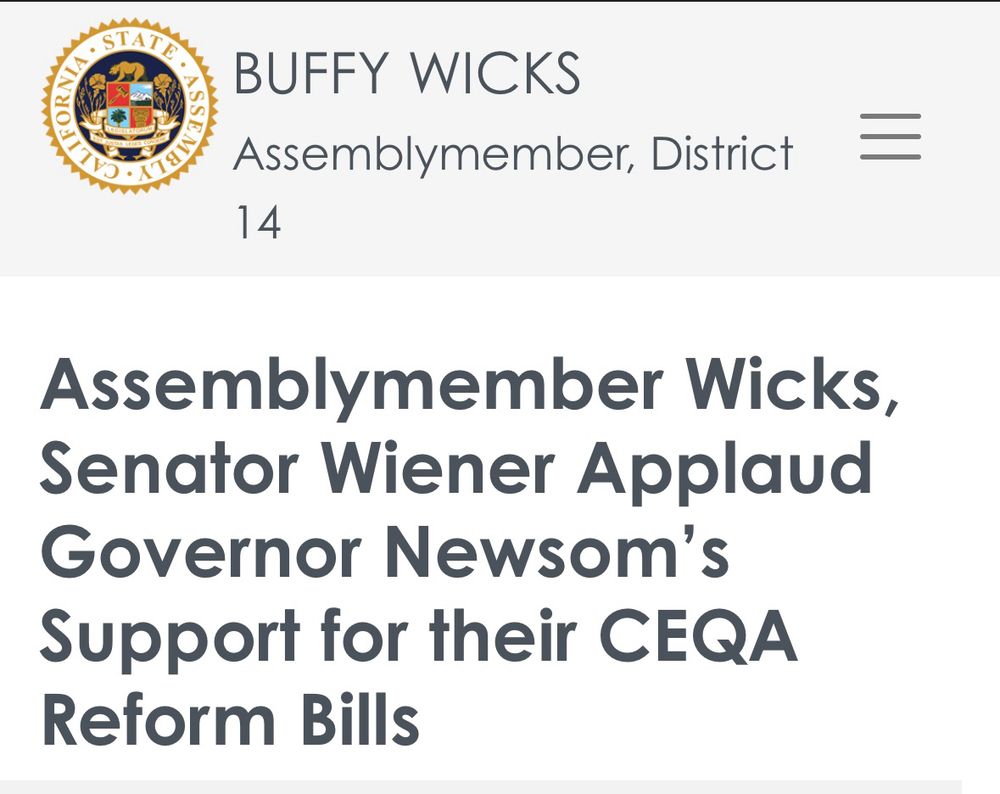
By championing the strongest CEQA reforms in decades, @governor.ca.gov is showing that CA is ready to meet this moment.
Building housing in environmentally responsible locations will tackle our housing crisis, advance our climate goals & deliver on the promise of a government that solves problems.
14.05.2025 19:29 — 👍 77 🔁 9 💬 5 📌 1
1/
Today @gavinnewsom.bsky.social showed his commitment to tackling the delays, costs & frivolous lawsuits that make it so hard to build in CA.
His proposed budget supports the strongest reforms to CEQA in decades by enacting my & @buffywicks.bsky.social’s CEQA reform bills, SB 607 & AB 609. 🧵
14.05.2025 21:07 — 👍 117 🔁 23 💬 10 📌 1
"In 2020, [Portland, OR] approved building [middle housing] on lots zoned for single family homes... A new report from the City says, it's working. 1,400 new units built in just a few years and each one is $300,000 less expensive than a typical single family home." @nbcnews.com
02.05.2025 23:30 — 👍 1748 🔁 386 💬 46 📌 126
No sir 😎
21.04.2025 17:03 — 👍 2 🔁 0 💬 1 📌 0
Donald Shoup revolutionized how we think about parking, cities, and transportation. His work will shape urban policy for generations. I was honored to have his support and will always be inspired by his legacy in his memory, Im revisiting this: www.bloomberg.com/news/feature...
08.02.2025 04:53 — 👍 4 🔁 0 💬 0 📌 0
SKPy to some
vegetable lover
Berkeley
Research | Data Science at the California Department of Social Services. All views my own.
Comms @cayimby.bsky.social. Advocacy at YIMBY Dems of SD. Previously Product Marketing @ U.S. Digital Response. Tweets on housing, climate change, and San Diego/California politics
Photography staff of the Los Angeles Times
Berkeley D2 Councilmember. Poet. Classicist. Cyclist. Urbanist. Go Gaels!
Berkeleyan, dad, dehydrator of foods, dork, pro-energy equity and pro-housing, anti-traffic violence and anti-racism
Diego and Leonel's dad. Writer. Houser.
Policy Director @ Up For Growth
Terner Center affiliate
Eden Housing Board member
Community Relations Officer at LA Metro
Original research and commentary on what matters for city success.
Educator, mom, corn aficionado, Berkeley School Board Director 🏳️🌈🌽🚌
Librarian, archivist, antifascist, naturalist, cyclist, longtime Berkeleyan/Mendocinan. Frequent frequenter of unfrequented places.
Official account for the City of Oakland, California ❤️ #OaklandLoveLife
linktr.ee/cityofoakland
UC Berkeley, Department of City and Regional Planning.
'The Equitably Resilient City: Solidarities and Struggles in the Face of Climate Crisis' (MIT Press 2024)
https://mitpress.mit.edu/9780262549868/the-equitably-resilient-city
berkeley city councilmember, district 7 • envisioner of utopian futures, passenger of public transportation, haver of opinions, & studier of history • she/they • 🇲🇽🌹
Reporter and editor at KQED/San Francisco. Transportation, history, transportation history, water, weather, water and weather, salmon and interests of all sorts. Photography is pretty cool.
Signal: danbrekke.95
BART board director District 3, Berkeley South Asian American history tour guide, public transit advocate, and native flower cosplayer. Also on IG at @berkeleywali.
Berkeley, CA: About to be the YIMBYest city in California.














